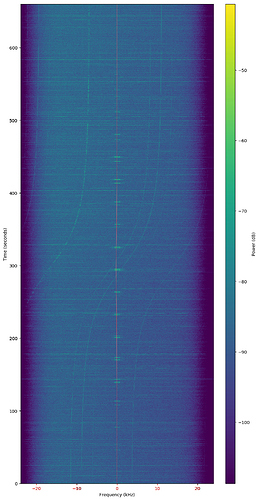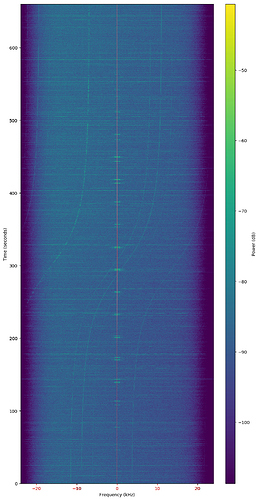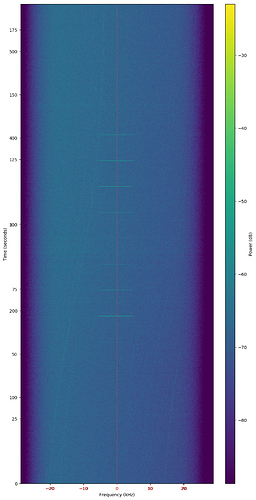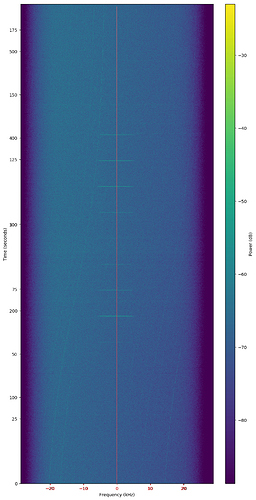we will follow him this night during the pass over europe
New TLE Set for Bobcat-1 and SPOC satellites, generated by @pierros using @cgbsat’s strf:
1 99837U 20310.95833333 .00000000 00000-0 48175-4 0 01
2 99837 51.6464 6.9635 0001675 100.2165 44.0495 15.50085220 01
We’ll be having a pass over the university ground station from 2020-11-06T04:42:02Z UTC to 2020-11-06T04:51:59Z UTC. We’re planning to resolve the baud rate issue so that Bobcat-1 will be back at 1200 baud, and hopefully start our first science data collection. The current theory as to why our baud rate is stuck at the high level is that the FTP task interrupted the task responsible for changing back the baud rate due to our command sequencing - simply increasing our baud rate change timeout should resolve this issue going forward.
After 11-06 04:51UTC, Bobcat-1 should be back in its 1200 baud beacon mode.
04:42 - 04:51 UTC pass complete. Downlink is back to 1200 baud FSK and we have started our first science data collection!
Congratulations for Bobcat-1, can you confirm that the cubesat uses a NanoCom AX100 ?? No signal from Neutron-1 tonight.
Yes, we have a GOMSpace NanoCom AX100 in Mode 5 (ASM+GOLAY). Let me know if you have any more questions!
Currently only SPOC is received. Unfortunately Bobcat-1 has stopped transmitting some hours ago, there will be some attempts from the team to contact it, also if it was a misconfiguration issue it will reset automatically within the next 24-48h.
I’ve scheduled more observations for the next two days for all the satellites, again if any station owner wants to schedule other satellite or ISS pass, please remove and re-schedule.
One more comment, the generated TLE fit very well SPOC and Bobcat-1.
As a point of information, the bandwidth of SATLLA-1 is set to 62.5 kHz.
I’ve received an email from the US Space Force:
Kevin,
We have preliminary orbits for the satellites now – they’re in what we call “analyst” status, which means we’re tracking them but are waiting for more tracking data to firm up the orbits before they go into the catalog. The crew believes one of two objects is Bobcat-1, and I’ve attached the TLEs for both of them. 85xxx numbers are used for analysts, and will be replaced by “normal” numbers when they go into the catalog.
The crew will be working over the weekend, so hopefully we’ll start getting them into the catalog by Monday. In the meantime, you can take a look at the TLEs and let me know if you can identify one as Bobcat-1. Take your time, no hurry.
Congrats on your new satellite!
Cynthia
These are the two files that Cynthia shared:
85416.tle.txt (329 Bytes)
85419.tle.txt (162 Bytes)
… which is wider than 48 kHz, hence the issue. The bandwidth has been mentioned a few times in the other thread: Identifying LoRa transmissions
Based on these post-deployment TLEs here are ikhnos results on the latest waterfalls with signal we have for each satellite:
Bobcat-1 - Observation 3090880
| Our generated TLE | 85416 TLE | 85419 TLE |
|---|---|---|
SPOC - Observation 3091117
| Our generated TLE | 85416 TLE | 85419 TLE |
|---|---|---|
All of them are too close, but it seems that 85419 fits a little better Bobcat-1, however I would say that I’m 60% sure about it.
For now we are going to keep our generated TLE as it doesn’t make a big difference and we will keep watching how it goes.
A quick update:
Bobcat-1 after a silence period is beaconing again.
SPOC continues to be received.
Unfortunately the rest of the satellites haven’t been received yet.
EDIT: There are several observations of DESCENT where there are RF collisions with 44045 MySat-1, so MySat-1 is visible in waterfall.
Thanks update Fredy! Good news on those two.
Several of us have recorded some decent-looking 38k4 packets from Bobcat-1, but so far no luck decoding it.
Does anyone know if Bobcat-1’s 38k4 packets are G3RUH AX.25 frames or something else?
Thanks for any guidance!
-Scott, K4KDR
If anyone else is looking for Bobcat-1 38k4 decode info, PE0SAT was kind enough to reply to me on twitter with an update: the proper 38k4 decode parameters can be added to the latest version of gr-satellites. I replayed my recording from last night w/ gr-satellites & the 38k4 packets decoded nicely. Here is the info from Jan:
Some updates:
- Bobcat-1 is back for good, after some experiments at 38k4 is now transmitting at 1k2 baud rate.
- SPOC continues beaconing, we will need some newer TLE, probably generate some tomorrow.
- Unfortunately no news for the rest of the satellites. There is a chance Neutron-1 to transmit at 435.275, so we have scheduled some more observations to verify that. However, we discovered that AIST-2D is transmitting at 435.270MHz, something that we need to add in DB.
- While trying to generate TLE for Bobcat-1, we noticed some unknown signal on the observations above Europe. After a lot of speculation, we managed to find out that it is AISTECHSAT-2 of AISTECHSPACE.
AISTECHSAT-2 was declined coordination by IARU as it was a non-amateur mission:
However they ignored the regulations and proceed with transmitting at 436.730 MHz, and we discovered now that they also transmit at 436.600 MHz.
Bobcat-1 update:
We got FTP working and downloaded our first little bit of experiment data! Unfortunately we had to reboot the OBC at the beginning of the pass, so we’ll be stuck at 38400 again for a few more passes till we have a chance to set it back to 1200.
All future observations of Bobcat-1 are now on the 38k4 transmitter.
Also after some analysis on a couple of observations it seems that we may have received NEUTRON-1.
https://network.satnogs.org/observations/3098495/ at ~250s
https://network.satnogs.org/observations/3098574/ at ~200s
https://network.satnogs.org/observations/3106837/ at ~40s
These signals seem to be drifted a lot, but it is normal as we follow ISS TLE for NEUTRON-1. Also they are not noise as there are other observations from stations far away from these ones that got at the same time the same signal.
Checking with TLE that nanoracks has shared with the NEUTRON-1 team, we can see that there is a fit, however as this is only one beacon in each observation is not 100% sure to say that is NEUTRON-1. These are the TLE that were used to check if they fit with the signal:
1 85421U 20311.64174749 +.00006677 +00000+0 +12458-3 0 00022
2 85421 51.6491 3.5815 0002381 351.1546 8.9401 15.50066020000286
EDIT: We are expecting to move to an updated TLE set for NEUTRON-1 in Network soon
Bobcat-1 is back at 1k2 baudrate. All future observation has been updated.
It should be a good point for the future development version of satnogs client, to add an option for the station owner for accept or not an observation of a non coordinated satellite transmitting in amateur radio band. This should give the owner of the station the freedom to co-opt this kind of situation or not ??





